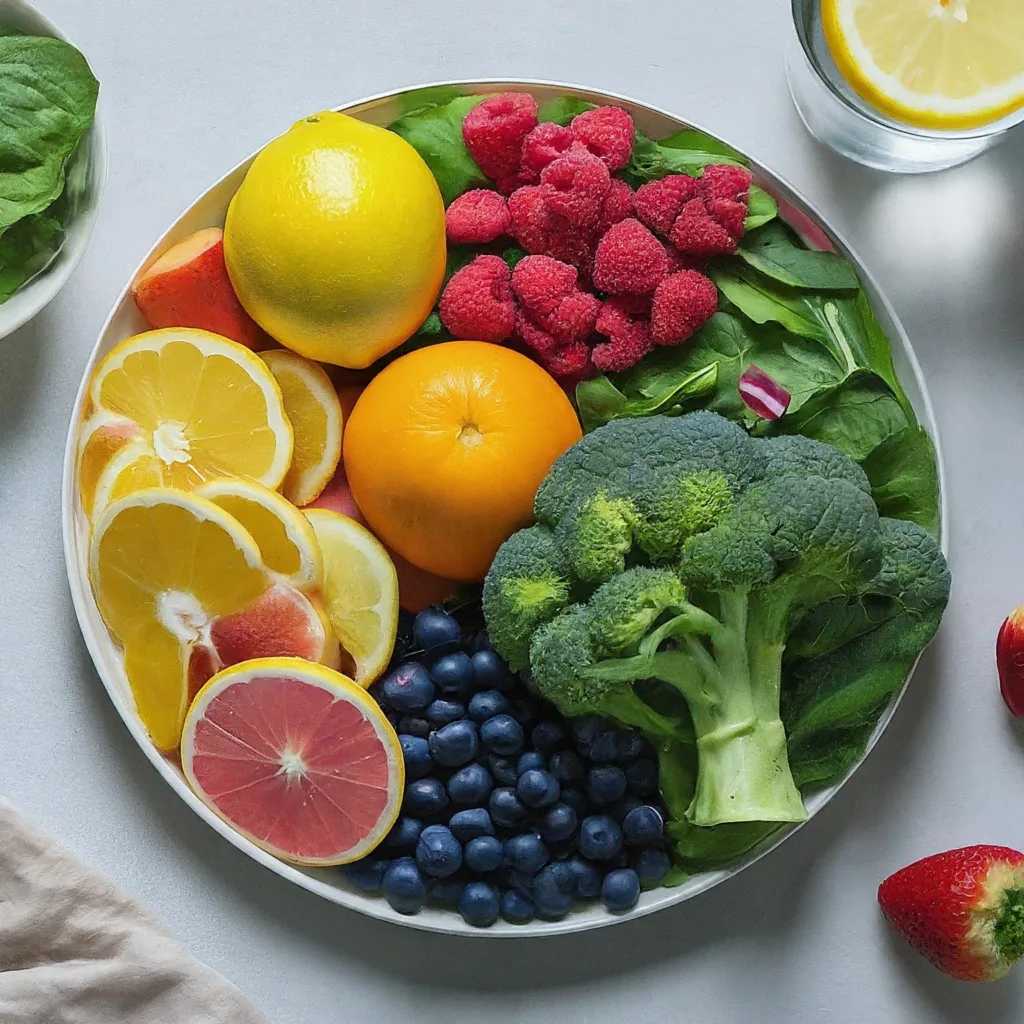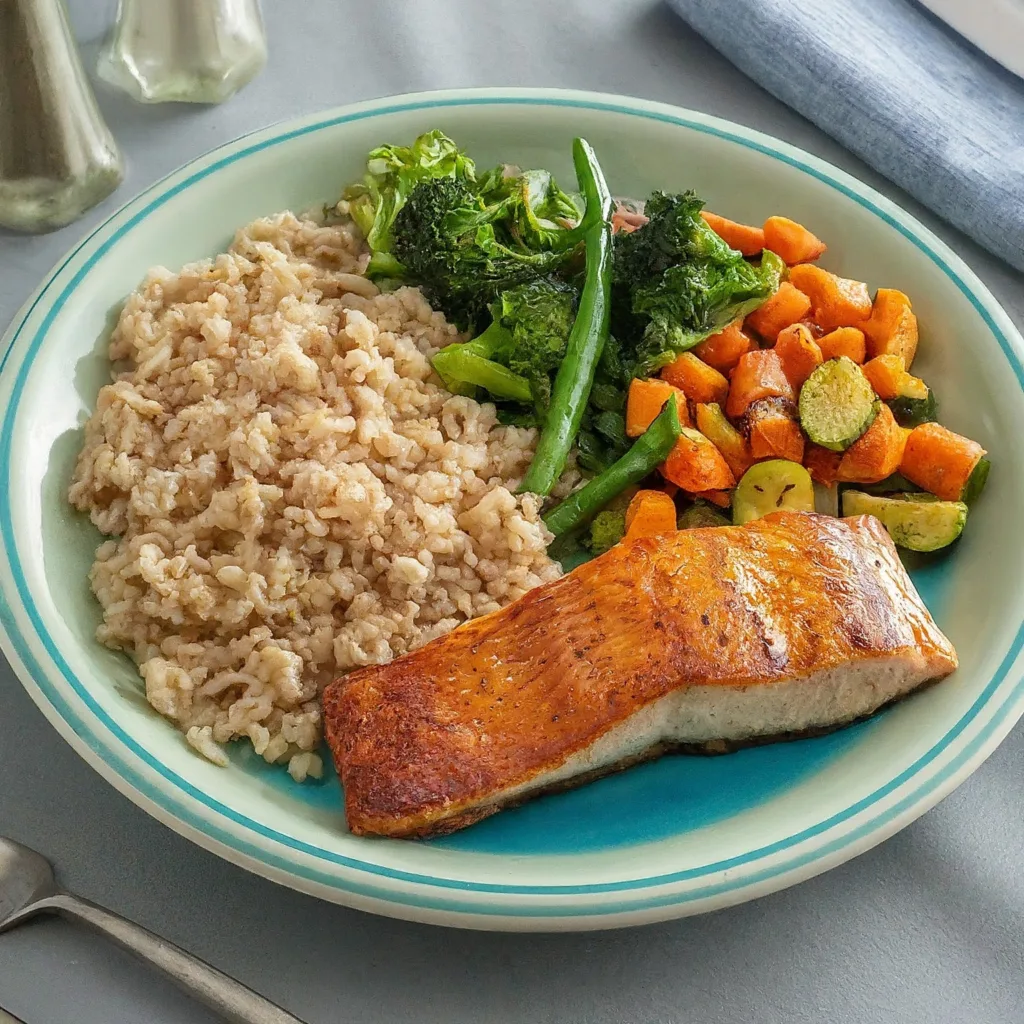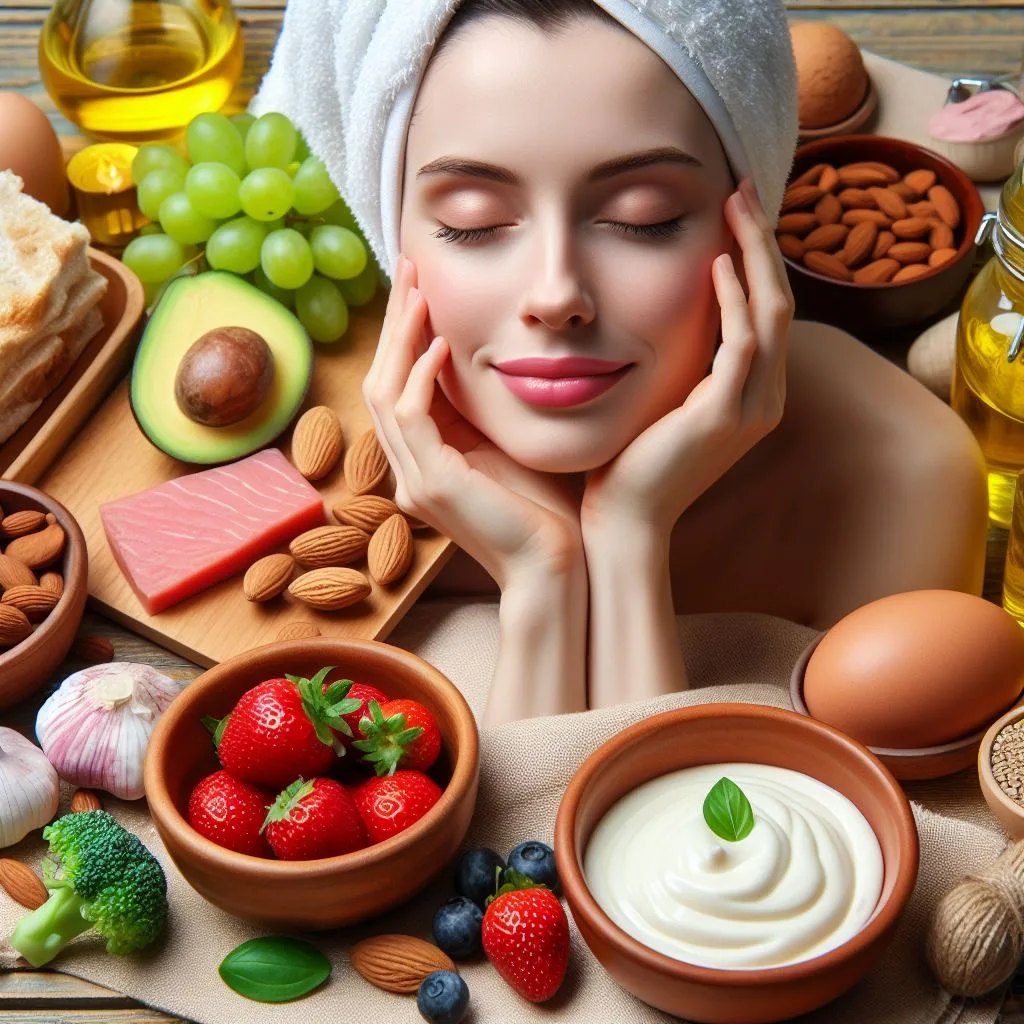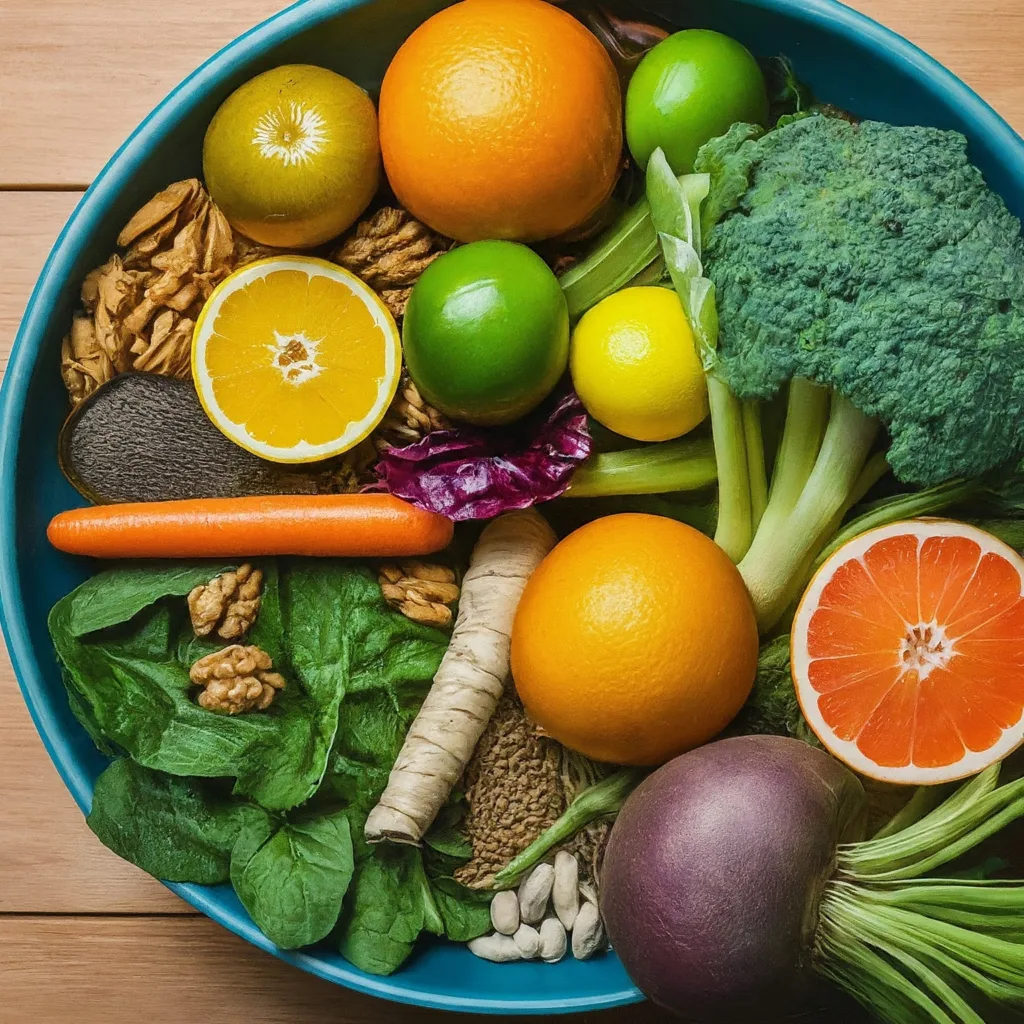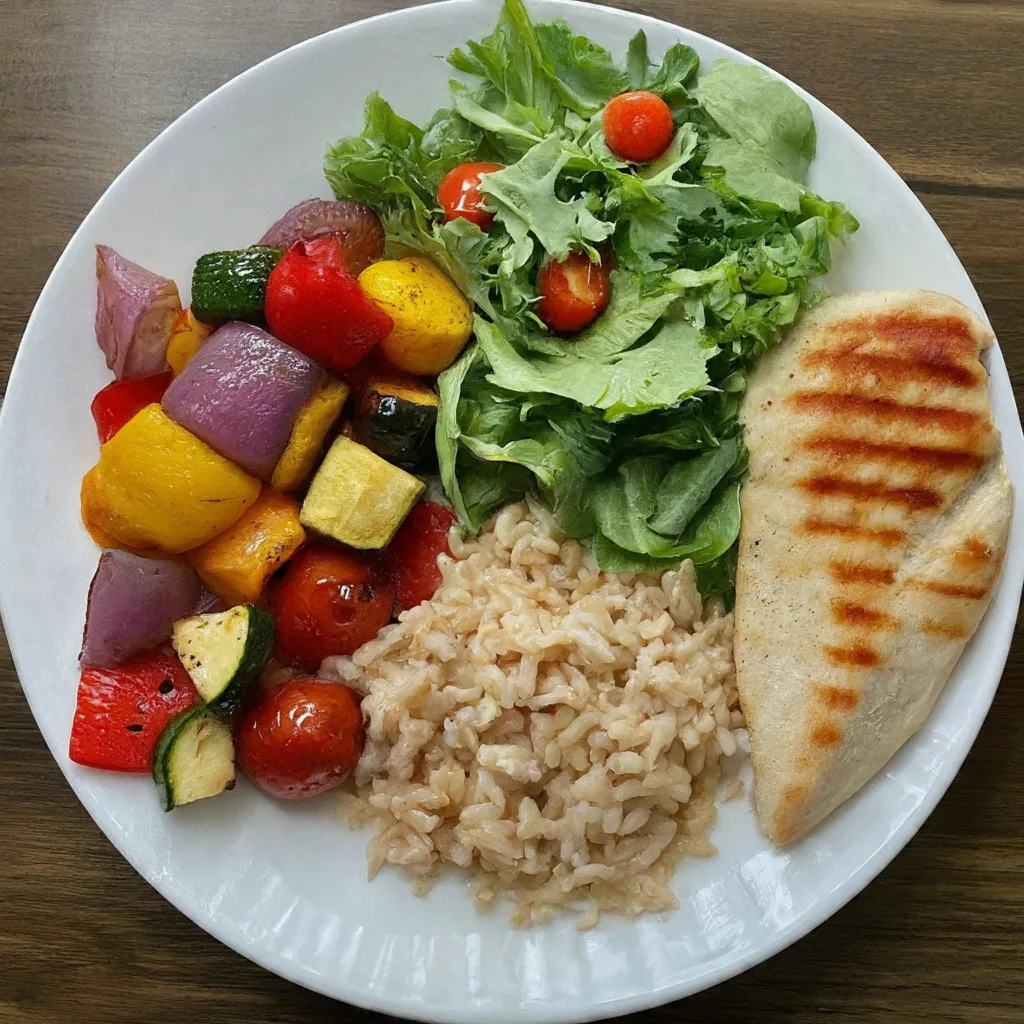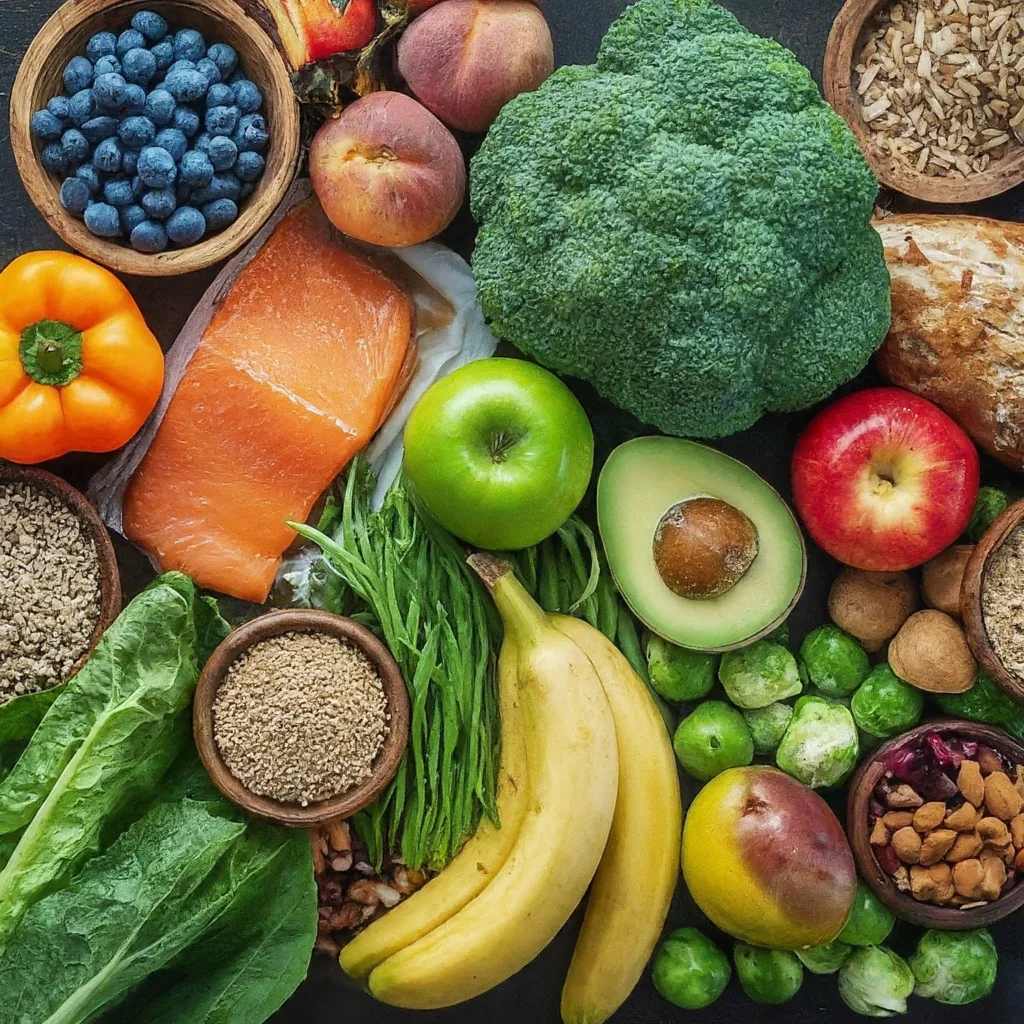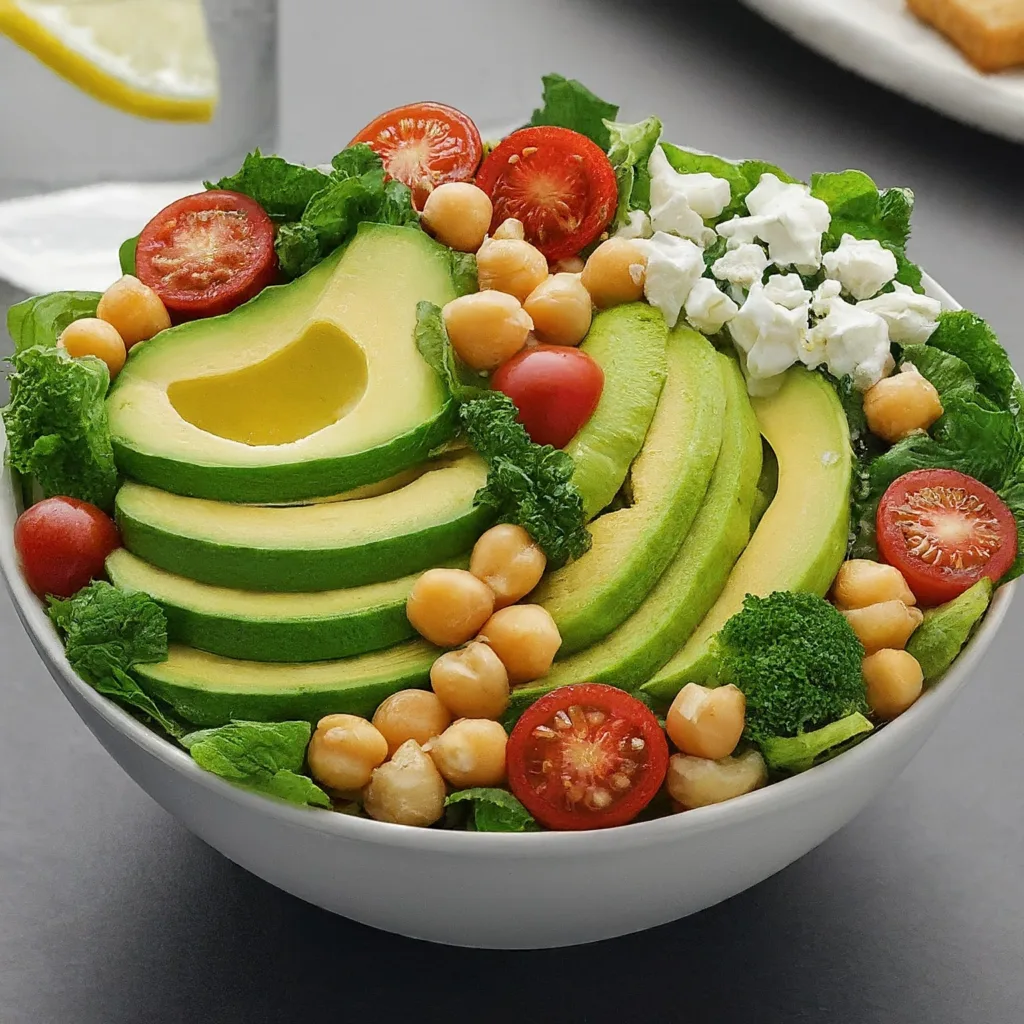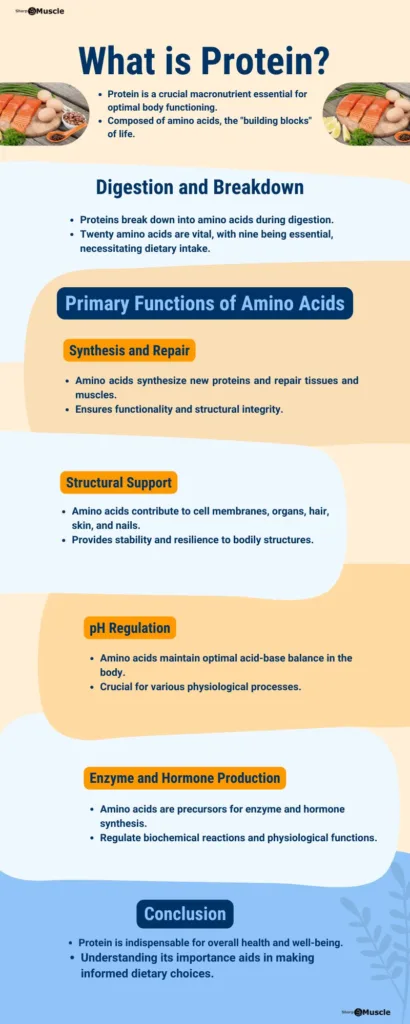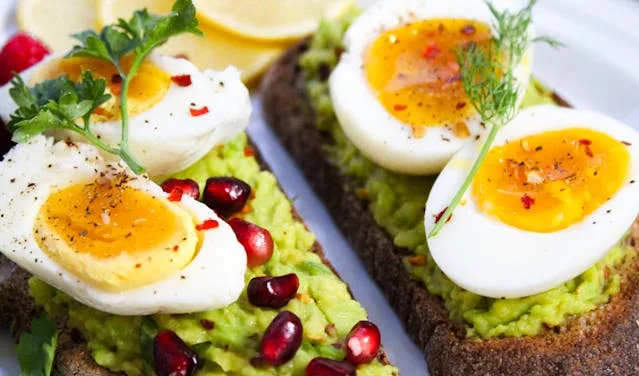Ever wonder why celebrities credit a “glowing complexion” to their diet? It’s not just genetics at play. There’s a growing interest in the connection between what you eat and the health of your skin. Alkaline foods for facial health, in particular, offer potential benefits. While the concept of a strictly “alkaline diet” has its complexities, there’s evidence to suggest that incorporating more alkaline foods can benefit your overall well-being, which can then positively reflect on your skin’s radiance.
In This Article
Understanding pH Balance and Facial Health
Let’s unpack the science of pH balance and its role in skincare.
The pH scale measures acidity and alkalinity. Our skin’s surface has a naturally slightly acidic pH, typically around 4.7. This acidic mantle acts as a protective barrier, shielding us from harmful bacteria and environmental irritants 1.
When this delicate balance is disrupted, towards a more alkaline state, it can lead to problems like dryness, irritation, and increased susceptibility to breakouts. 2
This highlights the importance of understanding pH dynamics when it comes to our skincare choices.
The Power of Alkaline Foods for Facial Health
The “alkaline diet” encourages consuming foods that leave an alkaline ash residue after the body metabolizes them. While the idea that this directly affects overall blood pH is a myth (the body tightly regulates it), research suggests these foods can still be beneficial 3.
Here’s where things get interesting for your skin: Alkaline foods are generally rich in vitamins, minerals, and antioxidants. These nutrients play a crucial role in:
- Collagen production: Collagen is the protein that keeps skin firm and youthful. Studies show that vitamin C, found in many alkaline fruits and vegetables, is essential for collagen synthesis 4.
- Fighting inflammation: Chronic inflammation can contribute to acne, rosacea, and other skin conditions. Alkaline foods like leafy greens often contain antioxidants that combat inflammation 5.
- Regulating sebum production: Sebum is an oily substance produced by the skin. When sebum production goes into overdrive, it can clog pores and lead to breakouts. Some studies suggest that zinc, abundant in certain alkaline foods like pumpkin seeds, may help regulate sebum production 6.
Building a Radiant Complexion with Alkaline Foods
Now, let’s get practical! How can you incorporate more alkaline foods into your diet for potential facial health benefits?
Here are some tips:
1. Focus on Fruits and Vegetables
Fill your plate with a colorful variety. These are some of the most alkaline-forming foods:
- Leafy Greens: Spinach, kale, arugula, collard greens, Swiss chard, romaine lettuce
- Berries: Blueberries, strawberries, raspberries, blackberries, cranberries, cherries
- Citrus Fruits: Lemons, limes, oranges, grapefruit
- Cruciferous Vegetables: Broccoli, cauliflower, cabbage, Brussels sprouts, bok choy
- Other Vegetables: Avocados, beets, cucumbers, celery, zucchini, onions, garlic, bell peppers, mushrooms, tomatoes
2. Explore Alkaline-Rich Beverages
Ditch sugary sodas for naturally alkaline options:
- Herbal Teas: Chamomile, peppermint, ginger, nettle, dandelion root
- Green Juices/Smoothies: Made with leafy greens, cucumber, celery, a touch of apple or pear for sweetness
- Water with Lemon: Lemon juice, despite tasting acidic, metabolizes as alkaline
- Coconut Water: A naturally hydrating, slightly alkaline beverage
- Almond Milk: Unsweetened varieties provide alkalinity
- Vegetable Broth: Homemade or low-sodium store-bought versions
3. Choose Alkaline Grains and Legumes
Opt for whole, unprocessed versions for the most benefits:
- Whole Grains: Quinoa, brown rice, millet, amaranth, buckwheat, wild rice
- Legumes: Lentils, chickpeas, black beans, kidney beans, navy beans, pinto beans
- Other: Almonds, pumpkin seeds, sunflower seeds, sesame seeds
Even within these lists, some foods might be more alkalizing for certain individuals than others. It’s a good idea to pay attention to how your body responds to various foods.
Alkaline Diet Recipes for Facial Health
Remember, a balanced diet is key. While incorporating more alkaline foods offers potential benefits, it’s not a miracle cure.
Breakfast
Here are the breakfast recipes for your vibrant start:
1. Energizing Green Smoothie
Blend spinach, kale, banana, frozen pineapple chunks, unsweetened almond milk, and a scoop of plant-based protein powder for a satisfying start.
How to make this recipe
Ingredients:
- Handful of fresh spinach
- Handful of kale leaves
- 1 ripe banana
- 1/2 cup frozen pineapple chunks
- 1 cup unsweetened almond milk
- 1 scoop of plant-based protein powder
Instructions:
- In a blender, combine spinach, kale, banana, frozen pineapple chunks, almond milk, and protein powder.
- Blend until smooth and creamy.
- Pour into a glass and enjoy the refreshing, nutrient-packed goodness to kickstart your day.
2. Quinoa Porridge with Berries
Cook quinoa according to instructions. Warm with your favorite plant-based milk, a dash of cinnamon, and top with fresh berries for an antioxidant boost.
How to make this recipe
Ingredients:
- 1/2 cup quinoa
- Your choice of plant-based milk (almond, coconut, soy, etc.)
- Dash of cinnamon
- Fresh berries (strawberries, blueberries, raspberries)
Instructions:
- Rinse quinoa thoroughly under cold water.
- In a saucepan, combine quinoa with water or plant-based milk according to package instructions.
- Cook until quinoa is fluffy and tender.
- Stir in a dash of cinnamon for flavor.
- Serve warm, topped with a generous amount of fresh berries for a burst of antioxidants and sweetness.
3. Avocado Toast Extravaganza
Top whole-grain toast with mashed avocado, sliced tomato, a sprinkle of hemp seeds, and a squeeze of lemon.
How to make this recipe
Ingredients:
- 1 ripe avocado
- Whole-grain bread slices
- Sliced tomato
- Hemp seeds
- Fresh lemon juice
Instructions:
- Toast whole-grain bread slices to desired crispness.
- Mash ripe avocado and spread it generously over the toast.
- Top with sliced tomato for a juicy burst of flavor.
- Sprinkle hemp seeds for added protein and crunch.
- Squeeze fresh lemon juice over the top to elevate the flavors.
- Enjoy this simple yet indulgent breakfast that nourishes your body and satisfies your taste buds.
Lunch
Here are the delicious lunch recipes for nourishment:
1. Rainbow Veggie Salad
Create a bed of mixed greens. Top with chopped cucumber, bell peppers, chickpeas, sprouts, olives, and a drizzle of olive oil and balsamic vinegar.
Ingredients:
- Mixed greens (spinach, kale, arugula, etc.)
- Chopped cucumber
- Sliced bell peppers (red, yellow, orange)
- Cooked chickpeas
- Fresh sprouts (alfalfa, broccoli, etc.)
- Sliced olives
- Extra virgin olive oil
- Balsamic vinegar
Instructions:
- Arrange a bed of mixed greens on a large plate or bowl.
- Top the greens with chopped cucumber, bell peppers, chickpeas, sprouts, and sliced olives.
- Drizzle with extra virgin olive oil and balsamic vinegar for a burst of flavor.
- Toss gently to combine, and enjoy a vibrant and nutritious salad that’s as beautiful as it is delicious.
2. Lentil and Sweet Potato Soup
A hearty blend of lentils, sweet potato chunks, carrots, onion, garlic, vegetable broth, and spices like cumin and turmeric.
Ingredients:
- 1 cup lentils (green or brown)
- 1 large sweet potato, peeled and diced
- 2 carrots, diced
- 1 onion, finely chopped
- 2 cloves garlic, minced
- 4 cups vegetable broth
- 1 teaspoon ground cumin
- 1/2 teaspoon ground turmeric
- Salt and pepper to taste
Instructions:
- In a large pot, sauté onions and garlic until fragrant.
- Add diced sweet potato, carrots, lentils, vegetable broth, cumin, and turmeric.
- Bring to a boil, then reduce heat and simmer until lentils and vegetables are tender, about 20-25 minutes.
- Season with salt and pepper to taste.
- Serve hot and enjoy the comforting warmth of this hearty lentil and sweet potato soup.
3. Quinoa Salad with Lemon-Herb Dressing
Combine cooked quinoa, chopped cucumber, tomatoes, fresh parsley, and a dressing of lemon juice, extra virgin olive oil, and a pinch of sea salt.
Ingredients:
- Cooked quinoa
- Chopped cucumber
- Cherry tomatoes, halved
- Fresh parsley, chopped
- Lemon juice
- Extra virgin olive oil
- Sea salt
Instructions:
- In a large bowl, combine cooked quinoa, chopped cucumber, halved cherry tomatoes, and fresh parsley.
- In a separate small bowl, whisk together lemon juice, extra virgin olive oil, and a pinch of sea salt to create the dressing.
- Drizzle the dressing over the quinoa salad and toss gently to coat.
- Serve chilled or at room temperature for a refreshing and satisfying meal option.
Snacks
Here are the satisfying snack ideas to fuel your day:
1. DIY Trail Mix
Combine almonds, pumpkin seeds, sunflower seeds, and dried fruits like cranberries or apricots.
Ingredients:
- Almonds
- Pumpkin seeds
- Sunflower seeds
- Dried fruits (cranberries, apricots, raisins)
Instructions:
- In a mixing bowl, combine almonds, pumpkin seeds, sunflower seeds, and your choice of dried fruits.
- Mix well to distribute the ingredients evenly.
- Transfer the trail mix to a resealable container or portion into snack-sized bags for easy grab-and-go options.
- Enjoy this nutrient-rich and customizable snack that provides a satisfying crunch and burst of energy.
2. Apple slices with Almond Butter
A simple, satisfying, and energizing snack.
Ingredients:
- Fresh apple, sliced
- Almond butter
Instructions:
- Wash and slice a fresh apple into thin wedges.
- Spread almond butter onto each apple slice.
- Arrange on a plate and enjoy the crisp sweetness of the apple paired with the creamy richness of almond butter for a delicious and nutritious snack that satisfies both sweet and savory cravings.
3. Hummus and Veggie Sticks
Opt for carrots, celery sticks, or bell pepper strips for dipping.
Ingredients:
- Hummus (store-bought or homemade)
- Carrot sticks
- Celery sticks
- Bell pepper strips
Instructions:
- Wash and prepare an assortment of fresh veggies such as carrot sticks, celery sticks, and bell pepper strips.
- Serve with a generous dollop of hummus for dipping.
- Indulge in this crunchy and flavorful snack that’s packed with fiber, vitamins, and minerals to keep you feeling satisfied and energized throughout the day.
Dinner
Here are the delicious dinner options for a satisfying meal:
1. Zucchini Noodles with Avocado Pesto
Spiralize zucchini or use a vegetable peeler for “noodles.” Blend avocado, basil, olive oil, lemon juice, garlic, and a touch of pine nuts for a creamy sauce.
Ingredients:
- Zucchini
- Ripe avocado
- Fresh basil leaves
- Olive oil
- Lemon juice
- Garlic cloves
- Pine nuts
Instructions:
- Spiralize zucchini into noodle-like strands using a spiralizer or use a vegetable peeler to create “noodles.”
- In a blender or food processor, combine ripe avocado, fresh basil leaves, olive oil, lemon juice, garlic cloves, and pine nuts.
- Blend until smooth and creamy to create the avocado pesto sauce.
- Toss the zucchini noodles with the avocado pesto sauce until evenly coated.
- Serve immediately for a light yet satisfying dinner option that’s bursting with flavor and nutrients.
2. Salmon with Roasted Vegetables
Bake or pan-fry salmon with your favorite seasonings. Roast broccoli, cauliflower, and Brussels sprouts with olive oil, salt, and pepper.
Ingredients:
- Salmon fillets
- Broccoli florets
- Cauliflower florets
- Brussels sprouts, halved
- Olive oil
- Salt and pepper
Instructions:
- Preheat the oven to 400°F (200°C).
- Season salmon fillets with salt, pepper, and your favorite seasonings.
- Place salmon on a baking sheet lined with parchment paper and bake for 12-15 minutes, or until cooked through.
- In a separate baking dish, toss broccoli florets, cauliflower florets, and Brussels sprouts with olive oil, salt, and pepper.
- Roast in the oven for 20-25 minutes, or until vegetables are tender and caramelized.
- Serve the roasted vegetables alongside the baked salmon for a hearty and nutritious dinner that’s rich in omega-3 fatty acids and essential vitamins.
3. Stuffed Sweet Potatoes
Bake sweet potatoes until tender. Top with black beans, chopped bell pepper, salsa, and a dollop of plain Greek yogurt (or plant-based alternative).
Ingredients:
- Sweet potatoes
- Black beans
- Chopped bell pepper
- Salsa
- Plain Greek yogurt or plant-based alternative
Instructions:
- Preheat the oven to 400°F (200°C).
- Wash sweet potatoes and prick them with a fork. Place on a baking sheet and bake for 45-60 minutes, or until tender.
- Meanwhile, heat black beans in a saucepan and season with your favorite spices.
- Once sweet potatoes are cooked, slice them open and fluff the flesh with a fork.
- Top each sweet potato with a generous spoonful of black beans, chopped bell pepper, salsa, and a dollop of plain Greek yogurt or plant-based alternative.
- Serve hot and enjoy the comforting and satisfying flavors of this nutrient-packed dinner option.
Tip:
1. Season to taste
Don’t be shy with fresh herbs and spices!
Experiment with different combinations to discover what flatters your palate. Herbs like basil, cilantro, parsley, and rosemary add brightness and freshness, while spices like cumin, turmeric, chili powder, and smoked paprika introduce depth and warmth.
A sprinkle of garlic powder, onion powder, or nutritional yeast can also add complexity.
2. Portion control:
Practice mindful eating, even with healthy meals.
It’s easy to overindulge, even on nutritious foods. Pay attention to your hunger cues and stop eating when you’re comfortably satisfied, not stuffed.
3. Hydration is Key for Balanced Skin
Here’s a bonus tip! Staying well-hydrated is crucial for maintaining healthy skin, regardless of diet. Drinking plenty of water helps flush toxins and keeps your skin plump and supple 7.
Here’s how it helps:
- Think of water as your body’s internal cleaning crew. It helps flush out toxins that can contribute to inflammation and breakouts.
- Well-hydrated skin cells are plump and resilient. This translates to a smoother, more youthful appearance and less pronounced fine lines.
- Water acts as a transport system, carrying essential nutrients to your skin cells for repair and regeneration.
- While drinking alkaline water won’t directly alter your blood’s pH, adequate hydration supports your skin’s natural ability to maintain its own pH balance.
Tips for Optimal Hydration
- Aim for 8+ glasses daily: This is a general guideline – listen to your body! You may need more in hot weather or during exercise.
- Flavor Boost: If plain water isn’t your favorite, infuse it with cucumber slices, citrus wedges, berries, or fresh mint.
- Supplement with other fluids: Herbal teas, green juices, and broths all count towards your fluid intake.
Can Alkaline Foods Help with Specific Skin Conditions?
Research on the impact of diet on specific skin conditions continues. While some studies suggest an alkaline diet may benefit those with acne by reducing inflammation 8, more robust research is needed.
There’s also some evidence that it may help manage eczema symptoms. 9
While the idea of an alkaline diet ‘curing’ skin problems is oversimplified, there’s potential for improvement in certain conditions. Here’s a breakdown:
- Acne: Some studies suggest that diets high in processed foods and refined sugars may contribute to inflammation, worsening acne breakouts 8. Alkaline foods, with their focus on anti-inflammatory fruits, vegetables, and healthy fats, could indirectly help by reducing this systemic inflammation.
- Eczema: Eczema is a chronic condition with a strong inflammatory component. In some cases, dietary triggers can worsen symptoms. While an alkaline diet isn’t a replacement for prescribed treatments, its focus on whole, unprocessed foods might help individuals sensitive to processed ingredients9.
- Other Skin Conditions: Research is emerging on the link between diet and conditions like psoriasis and rosacea. Since alkaline foods often prioritize antioxidant-rich fruits and vegetables, they could potentially support skin health across a range of concerns.
Important Considerations
An alkaline-focused diet is one tool, not a silver bullet. Skin health is influenced by genetics, stress levels, skincare habits, and more.
What works for one person may not work for another. If you have a skin condition, talk to your dermatologist to develop a personalized management plan.
While early results are promising, larger, well-controlled studies are necessary to confirm the specific benefits of an alkaline approach for different skin conditions.
Bottom line
Consider an alkaline-rich diet as a way to potentially support your skin health efforts from the inside out, alongside working with a dermatologist for targeted treatment of specific conditions.
Building a pH-Balancing Skincare Routine
Remember, a healthy complexion is about more than just what you eat! Complement your alkaline-rich diet with a gentle, pH-conscious skincare routine to support your skin from the outside in.
Here’s how:
Cleansers: Start Right. Harsh cleansers can strip your skin’s natural oils, disrupting the pH balance. Look for cleansers labeled “gentle,” “pH-balanced,” or formulated specifically for sensitive skin. Cream or oil-based cleansers are often a good choice, and double-cleansing (with an oil-based cleanser followed by a gentle one) can ensure thorough cleaning without irritation.
Toners: Restore & Refresh. Toners designed for sensitive skin can help restore your skin’s pH balance after cleansing. They can also remove lingering dirt or makeup and prep the skin for better absorption of serums and moisturizers. Look for alcohol-free formulas with hydrating ingredients like aloe vera or hyaluronic acid.
Masks: DIY Nourishment. Capitalize on those alkaline foods! Whipping up natural masks with ingredients like avocado (rich in healthy fats), cucumber (cooling and hydrating), or mashed banana (packed with antioxidants) provides a soothing and nourishing boost. You can even mix in a bit of raw honey for extra benefits.
Moisturizers: Seal the Deal. Moisturizing regularly helps keep your skin hydrated, which is crucial for a healthy pH balance. Seek out moisturizers labeled as “oil-free” and “non-comedogenic” if you’re oily or acne-prone. Look for ingredients like ceramides, which help strengthen the skin barrier, and hyaluronic acid, a powerful humectant that draws in moisture.
Sunscreen: The Non-Negotiable. Sun damage is a major contributor to premature aging, wrinkles, and hyperpigmentation – and can even worsen some skin conditions. Don’t let your diet and skincare efforts be sabotaged! Choose a broad-spectrum sunscreen with at least SPF 30 and apply it daily, even when it’s cloudy.
Extra Tips:
- Patch Test: Introduce new products one at a time to identify any potential irritants.
- Hydration Matters: Make sure the products you use actually hydrate, not just sit on the surface.
- Listen to Your Skin: If a product leaves your skin feeling tight, dry, or irritated, switch to a gentler option.
Monitoring Your Skin’s pH: Beyond the Strips
While at-home pH testing strips designed for skin are available, it’s important to understand their limitations. Several factors can impact their accuracy, including your skin’s moisture level, oiliness, and even sweat.
A more reliable approach to understanding your skin’s pH balance lies in observation:
- Reactions to products. Pay close attention to how your skin responds to various cleansers, toners, and moisturizers. Does it feel tight or dry after cleansing? Easily irritated by new products? Does it look generally dull or lack radiance? These could indicate a disrupted pH balance.
- If you make significant shifts in your diet (including focusing on alkaline foods), monitor how your skin reacts over time. Notice if there’s less dryness, improved oil control, or a calmer, more balanced appearance.
- When to use pH strips? Testing strips can be helpful for rough comparisons if you’re radically changing your skincare routine. This can give you a before-and-after snapshot, but long-term monitoring is best done through observation.
The Importance of Balance: Healthy Skin is About More Than pH
It’s easy to get caught up in the idea of achieving perfect alkalinity for flawless skin. However, remember that optimal health means finding a balance that works for YOU.
Here’s why:
- Restrictive diets can backfire. Eliminating entire food groups in pursuit of alkalinity can lead to nutrient deficiencies. Your skin needs vitamins, minerals, and healthy fats from a variety of sources to thrive.
- Gut health matters. A healthy gut microbiome is essential for overall skin health. Extremely restrictive diets can throw that balance off, potentially worsening skin issues.
- Individuality is key. What works for one person, even within an alkaline lifestyle, might not be optimal for another. Be mindful of how your body reacts to dietary changes.
Seek Professional Guidance: Optimizing Your Skin Health Through a Balanced Diet
If you’re considering major dietary shifts, regardless of the reasons, consulting a registered dietitian is wise. They can act as your personal guide on the path to a balanced and personalized meal plan that supports your overall health, including your skin. Here’s how a registered dietitian can help:
- They’ll take a comprehensive look at your health history, dietary habits, and lifestyle to create a plan that’s tailored to you.
- They’ll ensure your diet provides all the essential vitamins, minerals, proteins, and healthy fats your body needs for optimal skin health and overall well-being.
- If you have any existing skin conditions, a registered dietitian can work with your dermatologist to create a dietary approach that complements your medical treatment.
- They’ll help you develop sustainable dietary habits you can maintain for the long term, promoting healthy skin not just today, but for years to come.
- Proksch E. “pH in nature, humans and skin.” J Dermatol. 2018 Sep;45(9):1044-1052. doi: 10.1111/1346-8138.14489. Epub 2018 Jun 4. PMID: 29863755.[↩]
- Lambers H, Piessens S, Bloem A, Pronk H, Finkel P. “Natural skin surface pH is on average below 5, which is beneficial for its resident flora.” Int J Cosmet Sci. 2006 Oct;28(5):359-70. doi: 10.1111/j.1467-2494.2006.00344.x. PMID: 18489300.[↩]
- Schwalfenberg GK. “The alkaline diet: is there evidence that an alkaline pH diet benefits health?” J Environ Public Health. 2012;2012:727630. doi: 10.1155/2012/727630. Epub 2011 Oct 12. PMID: 22013455; PMCID: PMC3195546.[↩]
- Pullar JM, Carr AC, Vissers MCM. “The Roles of Vitamin C in Skin Health.” Nutrients. 2017 Aug 12;9(8):866. doi: 10.3390/nu9080866. PMID: 28805671; PMCID: PMC5579659.[↩]
- Minihane AM, Vinoy S, Russell WR, Baka A, Roche HM, Tuohy KM, Teeling JL, Blaak EE, Fenech M, Vauzour D, McArdle HJ, Kremer BH, Sterkman L, Vafeiadou K, Benedetti MM, Williams CM, Calder PC. “Low-grade inflammation, diet composition and health: current research evidence and its translation.” Br J Nutr. 2015 Oct 14;114(7):999-1012. doi: 10.1017/S0007114515002093. Epub 2015 Jul 31. PMID: 26228057; PMCID: PMC4579563.[↩]
- Ozuguz P, Dogruk Kacar S, Ekiz O, Takci Z, Balta I, Kalkan G. “Evaluation of serum vitamins A and E and zinc levels according to the severity of acne vulgaris.” Cutan Ocul Toxicol. 2014 Jun;33(2):99-102. doi: 10.3109/15569527.2013.808656. Epub 2013 Jul 5. PMID: 23826827.[↩]
- Palma L, Marques LT, Bujan J, Rodrigues LM. “Dietary water affects human skin hydration and biomechanics.” Clin Cosmet Investig Dermatol. 2015 Aug 3;8:413-21. doi: 10.2147/CCID.S86822. PMID: 26345226; PMCID: PMC4529263.[↩]
- Penso L, Touvier M, Deschasaux M, Szabo de Edelenyi F, Hercberg S, Ezzedine K, Sbidian E. “Association Between Adult Acne and Dietary Behaviors: Findings From the NutriNet-Santé Prospective Cohort Study.” JAMA Dermatol. 2020 Aug 1;156(8):854-862. doi: 10.1001/jamadermatol.2020.1602. PMID: 32520303; PMCID: PMC7287950.[↩][↩]
- Tanaka T, Kouda K, Kotani M, Takeuchi A, Tabei T, Masamoto Y, Nakamura H, Takigawa M, Suemura M, Takeuchi H, Kouda M. “Vegetarian diet ameliorates symptoms of atopic dermatitis through reduction of the number of peripheral eosinophils and of PGE2 synthesis by monocytes.” J Physiol Anthropol Appl Human Sci. 2001 Nov;20(6):353-61. doi: 10.2114/jpa.20.353. PMID: 11840688.[↩][↩]


